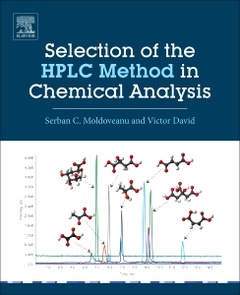Description
Selection of the HPLC Method in Chemical Analysis
Authors: Moldoveanu Serban C., David Victor
Language: English
Subject for Selection of the HPLC Method in Chemical Analysis:
Keywords
Analyte properties; Analytical information; Bare silica; Bidimensional separations; Bioaffinity; Buffer; Capillary IC column; Cellulose chiral phases; Chromatogram; Chromatographic parameters; Column properties; Column selection; Crown ether chiral phases; Cyclodextrins; Data evaluation; Decision process; Derivatization of silica; Detector selection; Dielectric constant; Dipole moment; Electrochemical methods; Electrochromatography; Electrophoresis; Elution mode; Elutropic strength; End-capping; Enthalpic effects; Gas chromatography; Glass phases; Gradient elution; Gradient in flow rate; Gradient of solvent composition; Gradient slope; HILIC; HPLC classification; HPLC column; Hydrophobicity; Immunoaffinity liquid chromatography; Inertness; Instrumentation in HPLC; Ion exchange stationary phase; Ionic capacity; Ionization; Ion-moderated stationary phase; Latex-agglomerated ion exchangers; Ligand exchange stationary phase; Macrocyclic antibiotics; Mass spectrometry; Matrix properties; Method development; Method implementation; Method optimization; Method validation; Methylene selectivity; Monoclonal antibody; Monolithic support; Nonhyphenated methods; Normal-phase stationary phase; Optical spectroscopy; pH gradient; Phase ratio; Pirkle phase; Polar stationary phase; Polarizability; Polyclonal antibody; Polymer-based SEC; Polysaccharides; Porosity; Postcolumn derivatization; Protein chiral phases; Quantitation; Retention equilibrium; Retention mechanism; Reversed-phase stationary phase; Sample; Selection of HPLC type; Separation; Silanol activity; Silica hydride-based phases; Silica-based SEC; Solvatochromic model; Statistics; Step gradient; Supercritical fluid chromatography; Support of stationary phase; USP classification.Zwitterionic HILIC
155.28 €
In Print (Delivery period: 14 days).
Add to cart598 p. · 19x23.3 cm · Paperback
Description
/li>Contents
/li>Readership
/li>Biography
/li>Comment
/li>
Selection of the HPLC Method in Chemical Analysis serves as a practical guide to users of high-performance liquid chromatography and provides criteria for method selection, development, and validation.
High-performance liquid chromatography (HPLC) is the most common analytical technique currently practiced in chemistry. However, the process of finding the appropriate information for a particular analytical project requires significant effort and pre-existent knowledge in the field. Further, sorting through the wealth of published data and literature takes both time and effort away from the critical aspects of HPLC method selection.
For the first time, a systematic approach for sorting through the available information and reviewing critically the up-to-date progress in HPLC for selecting a specific analysis is available in a single book. Selection of the HPLC Method in Chemical Analysis is an inclusive go-to reference for HPLC method selection, development, and validation.
1. Start of the Implementation of a New HPLC Method2. Short Overviews of Analytical Techniques Not Containing an Independent Separation Step3. Short Overviews of the Main Analytical Techniques Containing a Separation Step4. Basic Information Regarding the HPLC Techniques5. Properties of Analytes and Matrices Determining HPLC Selection6. General Aspects Regarding the HPLC Analytical Column7. RP-HPLC Analytical Columns8. Polar Analytical Columns9. Stationary Phases and Columns for Ion Exchange, Ion-Moderated, and Ligand Exchange Chromatography10. Stationary Phases and Columns for Chiral Chromatography11. Stationary Phases and Columns for Size Exclusion12. Stationary Phases and Columns for Immunoaffinity Type Separations13. Solvents, Buffers, and Additives Used in the Mobile Phase14. Gradient Elution15. The Practice of HPLC
Analytical chemists practicing HPLC and students at the graduate level taking related coursework in analytical chemistry
Dr. Victor David is a Professor and Head of the Department of Analytical Chemistry, University of Bucharest, Romania. He is the author of more than 120 publications, including 92 scientific papers in ISI international journals and 10 books and chapters in various Encyclopedias. He is also a reviewer at several international journals.
- Addresses the various aspects of practice and instrumentation needed to obtain reliable HPLC analysis results
- Leads researchers to the best choice of an HPLC method from the overabundance of information existent in the field
- Provides criteria for HPLC method selection, development, and validation
- Authored by world-renowned HPLC experts who have more than 60 years of combined experience in the field




